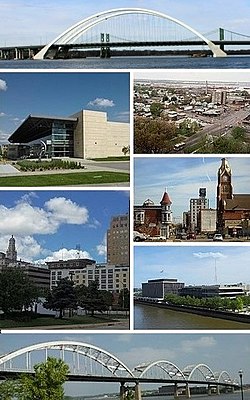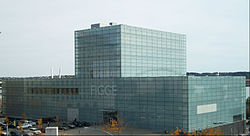- Eddie Albert, actor, Rock Island
- Ken Anderson, football player and coach, Rock Island
- Pat Angerer, football player, Bettendorf
- Matthew Ashford, actor, Davenport
- Tavian Banks, football player, Bettendorf
- Bonnie Bartlett, actress, Moline
- Scott Beck, filmmaker, Bettendorf
- Bix Beiderbecke, jazz musician, Davenport
- Louis Bellson, drummer, Moline
- Vincent Hugo Bendix, inventor and industrialist, Moline
- Ken Berry, actor, Moline
- Joseph W. Bettendorf, industrialist, Bettendorf (Gilbert)
- William P. Bettendorf, industrialist, Bettendorf (Gilbert)
- Black Hawk, band leader and warrior of the Sauk people
- Isabel Bloom, artist, Davenport
- Lisa Bluder, basketball coach, Marion
- Suzy Bogguss, country singer, Aledo
- Ken Bowman, football player, Milan
- Lara Flynn Boyle, actress, Davenport
- Ambrose Burke, priest and college president, Davenport
- Mike Butcher, pitcher and coach, Davenport
- Branden Campbell, bassist for the Neon Trees, Davenport
- Louise Carver, actress, Davenport
- Samuel Franklin Cody, aviator, Davenport
- William F. "Buffalo Bill" Cody, pioneer, LeClaire
- Danielle Colby, reality star American Pickers, Davenport/LeClaire
- Jude Cole, musician, Carbon Cliff
- Martin Cone, priest and college president, Davenport
- Ed Conroy, basketball coach, Davenport
- George Cram Cook, author, Davenport
- Roger Craig, football player, Davenport
- Doris Davenport, actress, Moline
- Colonel George Davenport, pioneer, US Army officer
- Dana Davis, actress, Davenport
- Ricky Davis, basketball player, Davenport
- John Deere, inventor, Moline
- Frederick Denkmann, lumber baron, Rock Island
- Justin Diercks, racecar driver, Davenport
- Acie Earl, basketball player, Moline
- Eugene Burton Ely, aviation pioneer, Davenport
- Lane Evans, United States congressman, Rock Island
- Bill Fitch, NBA basketball player and coach, Davenport
- John Flannagan, priest and college president, Davenport
- Jack Fleck, golfer, 1955 U.S. Open champion, Bettendorf
- Joe Frisco, vaudeville performer, Davenport
- John Getz, actor, Davenport
- Susan Glaspell, writer, Davenport
- Ethan Happ, Big Ten basketball player, Milan
- Warren Hearnes, governor of Missouri, Moline
- Austin Howard, football player, Davenport
- Jim Jensen, NFL running back, Davenport
| - Jesse Johnson (musician), The Time, Rock Island
- Mark Johnson, Olympic wrestler, Rock Island
- James Jones, football player, Davenport
- Gail Karp, cantor of the Reform Jewish synagogue, Davenport
- Hazel Keener, actress, Bettendorf and Davenport
- Madison Keys, tennis player, Rock Island
- Josh Kroeger, athlete, Davenport
- Steve Kuberski, basketball player, Moline
- Perry Lafferty, producer, Davenport
- Kari Lake, political figure, Rock Island
- Elmer Layden, athlete and coach, Davenport
- Jim Leach, politician, Davenport
- Johnny Lujack, quarterback, 1947 Heisman Trophy winner, Bettendorf
- Sue Lyon, actress, Davenport
- Helen Mack, actress, Rock Island
- Cletus Madsen, priest and college president, Davenport
- Stuart Margolin, actor and director, Davenport
- Elisabeth Maurus, musician, Rock Island
- Carl Meinberg, priest and college president, Davenport
- Sebastian Menke, priest and college president, Davenport
- Julia Michaels, musician, Davenport
- Pat Miletich, MMA fighter, Bettendorf
- Marvin Mottet, priest, Davenport
- Don Nelson, NBA basketball player and coach, Rock Island
- Michael Nunn, boxer, Davenport
- Spike O'Dell, radio personality, East Moline
- Gerald Francis O'Keefe, priest, Davenport
- Gene Oliver, MLB player, Rock Island
- Eric Christian Olsen, actor, Bettendorf
- Daniel David Palmer, chiropractor, Davenport
- Oran Pape, state patrol, Davenport
- Laurdine Patrick, musician, East Moline
- Mary Beth Peil, actress and singer, Davenport
- Nat Pendleton, wrestler and actor, Davenport
- Roger Perry, actor, Davenport
- James Philbrook, actor, Davenport
- Scott Pose, MLB baseball player, Davenport
- Hiram Price, politician, Davenport
- Margo Price, country singer, Aledo
- Linnea Quigley, actress and producer, Davenport
- Ed Reimers, announcer, Moline
- Otto Frederick Rohwedder, engineer, inventor of sliced bread, Davenport
- Seth Rollins, WWE wrestler, Davenport
- Randy Shilts, journalist, Davenport
- Jim Skinner, CEO of McDonald's, Davenport
- Roby Smith, Treasurer of Iowa, Davenport
- Dean Stone, MLB pitcher, Silvis
- Tim Sylvia, MMA fighter, Bettendorf
- Julian Vandervelde, football player, Davenport
- Hynden Walch, actress, Davenport
- Henry Cantwell Wallace, U.S. Secretary of Agriculture, Rock Island
- Friedrich Weyerhäuser, lumber baron, Rock Island
- Dwight Deere Wiman, Broadway producer, Moline
- Bryan Woods, filmmaker, Bettendorf
- Dave Blunts, Rapper, Davenport
|









